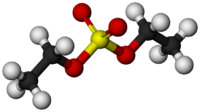Chemistry:Diethyl sulfate

| |

| |
| Names | |
|---|---|
| Preferred IUPAC name
Diethyl sulfate | |
| Other names
Sulfuric acid diethyl ester
| |
| Identifiers | |
3D model (JSmol)
|
|
| ChEBI | |
| ChEMBL | |
| ChemSpider | |
| KEGG | |
PubChem CID
|
|
| RTECS number |
|
| UNII | |
| |
| |
| Properties | |
| C4H10O4S | |
| Molar mass | 154.18 g·mol−1 |
| Appearance | Colorless liquid |
| Density | 1.2 g/mL |
| Melting point | −25 °C (−13 °F; 248 K) |
| Boiling point | 209 °C (408 °F; 482 K) (decomposes) |
| decomposes in water | |
| Vapor pressure | 0.29 mm Hg |
| -86.8·10−6 cm3/mol | |
| Hazards | |
| GHS pictograms |   
|
| GHS Signal word | Danger |
| H302, H312, H314, H332, H340, H350 | |
| P201, P202, P260, P261, P264, P270, P271, P280, P281, P301+312, P301+330+331, P302+352, P303+361+353, P304+312, P304+340, P305+351+338, P308+313, P310, P312, P321, P322, P330, P363, P405, P501 | |
| NFPA 704 (fire diamond) | |
| Flash point | 104 °C (219 °F; 377 K) |
| Related compounds | |
Related compounds
|
Dimethyl sulfate; diethyl sulfite |
Except where otherwise noted, data are given for materials in their standard state (at 25 °C [77 °F], 100 kPa). | |
| Infobox references | |
Diethyl sulfate (DES) is a highly toxic, combustible, and likely carcinogenic chemical compound with the formula (C2H5)2SO4.[1] It occurs as a colorless, oily liquid with a faint peppermint odor and is corrosive to tissue and metals.[2][1] Diethyl sulfate is used as an alkylating agent to prepare ethyl derivatives of phenols, amines, and thiols. It is used to manufacture dyes and textiles.[2]
Property
Diethyl sulfate is moisture sensitive liquid. Heating can lead to release of toxic gases and vapors.[3] It gets darker over time.[2] It forms ethyl alcohol, ethyl sulfate, and eventually sulfuric acid when exposed to water. This compound is also combustible; when burned, sulfur oxides, ether, and ethylene are produced.[1]
Toxicity
Diethyl sulfate is a strong alkylating agent which ethylates DNA, causing both somatic and germ cell mutations, and is therefore genotoxic.[4] According to the International Agency for Research on Cancer (IARC), as of 1999 there is not sufficient evidence for the carcinogenic properties of diethyl sulfate in humans, but there is in animals. It is classified as a Group 2A (probably carcinogenic to humans) carcinogen by the IARC.[5] Experimentation with animals has suggested this compound is likely carcinogenic to humans as it was implicated in the development of laryngeal cancer.[6] Evidence of the effects of this chemical compound on reproductive or developmental health is also lacking.[7]
Inhalation of this chemical compound has potential to be fatal and can induce nausea or vomiting. Swallowing this substance could also be fatal or lead to nausea, vomiting, or severe abdominal pain. Contact with or absorption through the skin also has potential to be fatal, and can cause severe burns.[8]
Preparation
Diethyl sulfate can be prepared by the reaction of oleum with diethyl ether or ethanol, after which the product is purified by vacuum distillation.[9] Another method involves dissolving ethylene in concentrated sulfuric acid.[9] Diethyl sulfate is produced commercially at scale and is sold by a variety of chemical suppliers.[10]
References
- ↑ 1.0 1.1 1.2 "DIETHYL SULFATE | CAMEO Chemicals | NOAA". https://cameochemicals.noaa.gov/chemical/3212.
- ↑ 2.0 2.1 2.2 "NCI Thesaurus". https://ncit.nci.nih.gov/ncitbrowser/ConceptReport.jsp?dictionary=NCI_Thesaurus&ns=NCI_Thesaurus&code=C44375.
- ↑ "SAFETY DATA SHEET--Diethyl sulfate". Aug 21, 2018. https://www.fishersci.com/store/msds?partNumber=AC114560250&productDescription=DIETHYL+SULFATE%2C+99%25+25ML&vendorId=VN00032119&countryCode=US&language=en.
- ↑ "Agents Classified by the IARC Monographs, Volumes 1–129 – IARC Monographs on the Identification of Carcinogenic Hazards to Humans". https://monographs.iarc.who.int/agents-classified-by-the-iarc/.
- ↑ IARC (1999). Diethyl Sulfate. Summaries and Evaluations. 71. International Agency for Research on Cancer (IARC). p. 1405. http://www.inchem.org/documents/iarc/vol54/04-diethyl-sulfate.html.
- ↑ "NCI Thesaurus". https://ncit.nci.nih.gov/ncitbrowser/ConceptReport.jsp?dictionary=NCI_Thesaurus&ns=NCI_Thesaurus&code=C44375.
- ↑ "Diethyl Sulfate". https://www.epa.gov/sites/production/files/2016-09/documents/diethyl-sulfate.pdf.
- ↑ "DIETHYL SULFATE | CAMEO Chemicals | NOAA". https://cameochemicals.noaa.gov/chemical/3212.
- ↑ 9.0 9.1 Dow (June 24, 2006). Diethyl Sulfate. Product Safety Assessment. Dow Chemical Company. http://msdssearch.dow.com/PublishedLiteratureDOWCOM/dh_0056/0901b8038005696b.pdf?filepath=productsafety/pdfs/noreg/233-00270.pdf&fromPage=GetDoc. Retrieved 2016-03-05.
- ↑ PubChem. "Hazardous Substances Data Bank (HSDB) : 1636" (in en). https://pubchem.ncbi.nlm.nih.gov/source/hsdb/1636#section=U-S-Production.
Further reading
- Buck, J. R.; Park, M.; Wang, Z.; Prudhomme, D. R.; Rizzo, C. J. (2000). "9-Ethyl-3,6-Dimethylcarbazole (DMECZ)". Organic Syntheses 77: 153. http://www.orgsyn.org/demo.aspx?prep=v77p0153.; Collective Volume, 10, pp. 396
- Theodore, S.; Sai, P. S. T. (2001). "Esterification of Ethanol with Sulfuric Acid: A Kinetic Study". Canadian Journal of Chemical Engineering 79 (1): 54–64. doi:10.1002/cjce.5450790109.
External links
- "Diethyl sulfate". Webbook. NIST. http://webbook.nist.gov/cgi/cbook.cgi?ID=C64675.
- "DIETHYL SULFATE -- ICSC: 0570". Inchem. http://www.inchem.org/documents/icsc/icsc/eics0570.htm.
- Diethyl sulfate. IARC Monographs. 71. IARC. 1992. http://monographs.iarc.fr/ENG/Monographs/vol71/mono71-92.pdf.
 |


